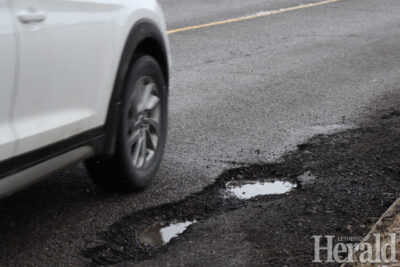Freeze-thaw cycles impact pothole numbers in city
By Alejandra Pulido-Guzman - Lethbridge Herald on March 30, 2023.
 Herald photo by Alejandra Pulido-Guzman
A series of potholes along College Drive South can be observed while a vehicle drives by earlier this week
Herald photo by Alejandra Pulido-Guzman
A series of potholes along College Drive South can be observed while a vehicle drives by earlier this weekLETHBRIDGE HERALDapulido@lethbridgeherald.com
Have you been wondering why there are so many potholes on the roads across the city, and how they seemed to have come out of nowhere? Have you ever wonder how potholes are formed?
Civil Engineering Technology instructor at Lethbridge College, Doug May said the number of potholes is proportional to the freeze-thaw cycles we experience through winter.
“As the weather begins to warm after a cold period, you get moisture that basically gets absorbed into the asphalt layers in areas where there might be cracking,” said May.
He said usually you see potholes at the end of a crack once they become more dense since that is where moisture usually finds its way to the lowest point of the road among the layers of asphalt.
“And then of course we get a freeze again and when water freezes it expands, and when it expands it creates pressure within the void spaces that are within the layer of asphalt and it expands to a point beyond what the asphalt will allow it to stretch, and then when it thaws it contracts. When this happens over and over again it begins to break down the bond between the asphalt cement and the aggregate, and the pothole is then created,” said May.
He said that doing road maintenance every spring helps, but eventually water will find its way back.
May added potholes are best addressed promptly after created because if too much time passes and too many cars go over one, the pothole will grow.
“What happens is as a vehicle passes over it, it pulls up a little bit of pavement every time which reduces the volume of asphalt, and then it opens up a little bit more especially with winter tires as they tend to grab and pick up the little tiny pebbles and then you can hear them kind of rattling around in your wheel well as you begin to speed up,” said May.
He said if potholes get deep to the point where the aggregate (rock) layer is exposed, just filling the hole is no longer an option and therefore road maintenance costs goes up.
“If a pothole goes deep enough and then gets down to your granulars,(rocks) what you’re going to do then is you’re going to change the soil structure so that it’s not as supportive as it would be, because typically with a soil structure you want to have very little void space and it is at its maximum density, so once you begin to lose density you lose strength,” said May.
He said at that point the hole would not be enough to be filled and instead a road section needs to be replaced. Usually a square section bigger than the hole gets cut out and refilled to make sure the road structure is maintained by compacting the soil layer and filling up any gaps caused by the pothole.
Follow @APulidoHerald on Twitter
14-13


